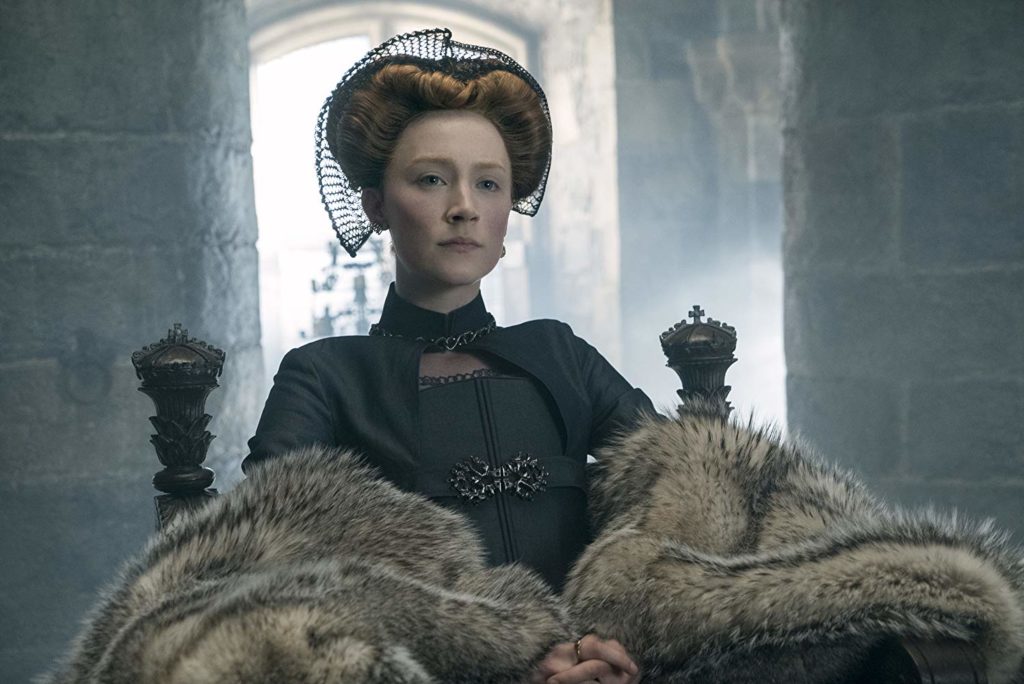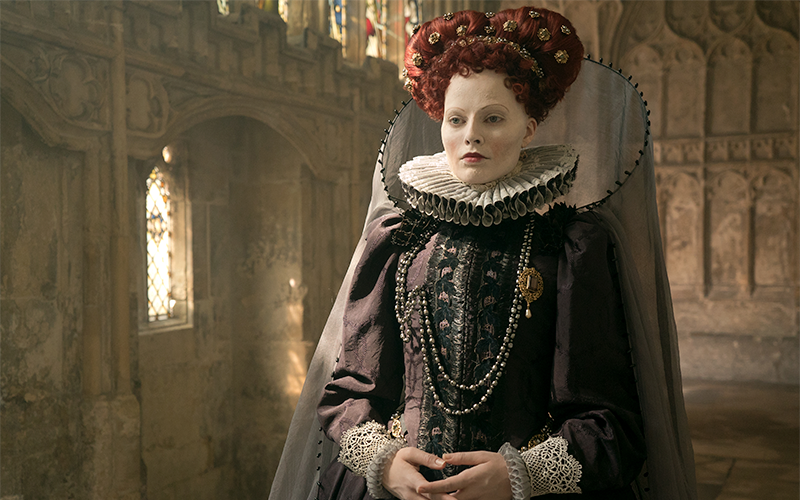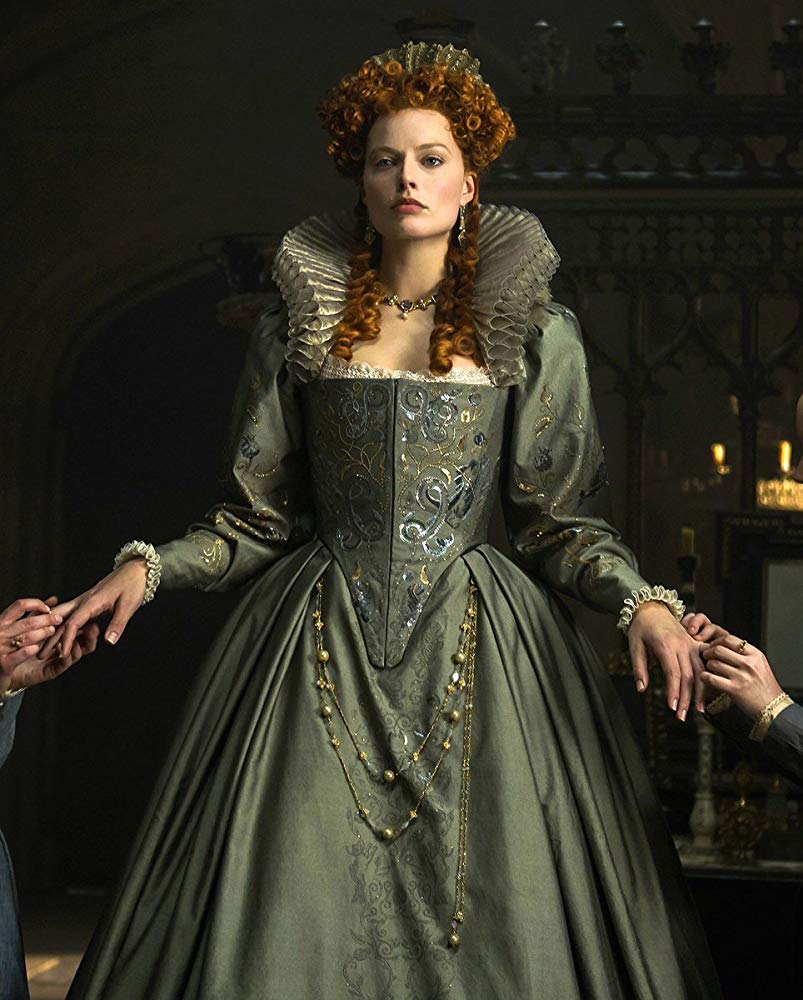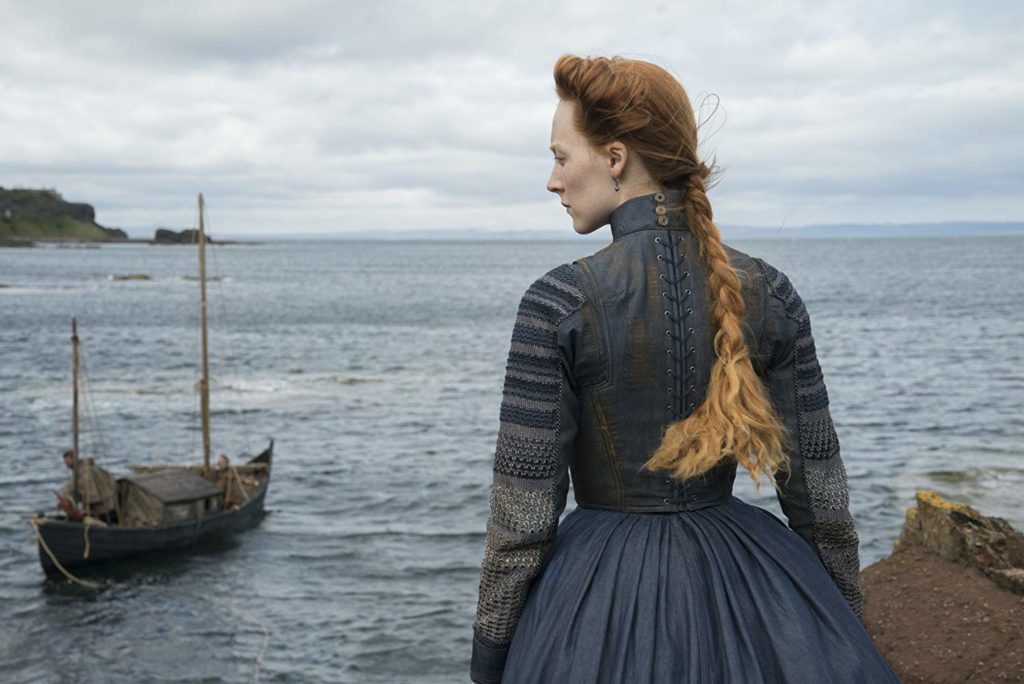Already well familiar with the beauty makeup and hair master artisan JENNY SHIRCORE brought to Cate Blanchett as Elizabeth I in “Elizabeth” and “Elizabeth: The Golden Years”, we are now treated to Shircore’s skills in MARY QUEEN OF SCOTS as she not only enhances the natural beauty of Saoirse Ronan as Mary Stuart but “uglifies” Margot Robbie as Elizabeth in the years of her affliction with smallpox and resulting lifelong scarring. It’s a testament to Shircore and her talents to turn the luminous Margot Robbie into a blistered, pox-marked, white-faced Elizabeth with scarecrow sticks for hair hidden beneath lustrous wigs. Her work is masterful as we see the layers of destruction to Elizabeth’s skin as time ravages her and the worse the scars and keloids become, the heavier the identifiable white-face cover-up. On the flip side, Shircore celebrates the youthful natural glow of Ronan’s Mary with a sun-kissed light touch. Wigs for each woman bode authenticity not only to portraitures and styles of the day but also speak to the character and power posturing of each. And while Robbie’s make-up for Elizabeth was the most time-consuming craft, on Ronan’s Mary the hair was “the thing.” Hairstyles for the supporting female characters and those for the men are all period authentic yet distinctive, with one of the most masterful hirsute examples found on David Tennant as John Knox.

Like Shircore’s costuming counterpart and frequent collaborator Alexandra Byrne, seeing the new visual design taken with Elizabeth I and her court contrast her prior work with the famed characters, and then the point-counterpoint approach with Mary I of Scotland and her court is not only exciting but helps to fuel the telling of the history of these two queens, adding to and helping to define each as a ruler, as a woman.
Already an Oscar winner for her work in “Elizabeth”, as well as an Oscar nominee for “The Young Victoria”, JENNY SHIRCORE is again an Oscar frontrunner this year for her work in MARY QUEEN OF SCOTS.
I spoke with Jenny in this very animated and fun interview going in-depth on her research process into smallpox, wig making, designing the make-up palette for each character, and driving the characters and the story forward through hair and make-up. . .
I am very, very happy to be talking with you, Jenny. You blew my mind with your hair and makeup in MARY QUEEN OF SCOTS. To uglify Margot Robbie like that, I don’t know how you did it. You are so good with period pieces, fantasy pieces. And while I have you, Jenny, I also have to tell you what you did on “The Nutcracker and the Four Realms” is incredible, totally fantastical. I easily could imagine hearing your name called out twice come Oscar nominations morning with a nod for each of these films.
Oh gosh, thank you!
With “Nutcracker”, the costuming and your hair and makeup are truly the best parts of that film. And, I love what you did with Helen Mirren. That was fabulous.
Thank you very much. It was such fun. It was just the most pure fun I’ve ever had. It was great. She was supposed to be an ill-treated doll.

And then I look at what you give us with MARY QUEEN OF SCOTS, and particularly Margot as Elizabeth. How did you tackle this? First, we have her with just basic makeup, but then we go into the smallpox and the severity of that and then the scarring from that and then continual layering on of that white Kabuki make-up while at the same time making the eyes just so alive and so dark.
Well, for me, it was invigorating and interesting, and it’s all I do. And, it’s what keeps me awake at night, and it’s thoughts going round and round in your head, and it’s what, for me, was my understanding of how to do the whole film of when it was written in the script that Elizabeth has smallpox, and of course, she did have and nearly died with it. For me, it was that handle that I grabbed on to and sort of just brandished myself up to do the rest of the film because when we did Elizabeth, we took her straight down the route of the virgin queen to the white virgin and makeup, shaving her head and putting the wig on, but for this, the route of smallpox took me down a different route to the iconic portrait of Elizabeth. And, also what it did for me was it showed me what I should do with Mary Queen of Scots as well. So, you can’t, for me, discuss one queen without talking about the other one because it was so point and counterpoint with each other all the way through the film. So I think it was like a moment when I’d read the script and thought how am I gonna do this, and it dawned on me that yes, this is how I change Margot Robbie by giving her the smallpox. That I used to my advantage.
So, that meant that I studied smallpox. I got everything on the Internet that could be got out on smallpox, all the pictorial references and then search with pictures of Margot Robbie drawing the position where I needed the boils and blisters to be on her face, so that I could then cover the scarring that’s left by the boils and do this with this makeup, and that will change her features. So, I had to borrow some gifted face. Margot Robbie’s lovely, sumptuous bottom, which I would then cover with makeup up and then change her lovely, sumptuous bottom then into a thin mean bug and put the scars and blisters up in her eyebrows, bridge of her nose, etc., thereby, planning her makeup that would cover the scar and give us a different face at the end, and all the while our Margot, while delivered from the suffering, this indignity of her beauty being lost, we’re building up Mary Queen of Scots into a mature woman, into a structured woman, into a woman who is presenting herself with all the dignity of a queen which is what her sole purpose is coming back to Scotland to claim her throne in Scotland and her right to the English throne.

I love the contrast between the two, Jenny. You mentioned the clean line with Saoirse as Mary Queen of Scots, and everything about her, a very fresh face, but a strong face, very clean, very pure. Between the two, to look at them, you would think that she was the virgin queen because of the clean lines and very nature of the makeup, the hair, the clothes. I love the contrast with the hair, with the wigs it did between the two. Speaks volumes as to each woman.
Good! I’m so glad. This is one main film that you live, eat, sleep, breathe it, you know? You can’t let go, and you have to know exactly the scene you’re doing could be a scene where Elizabeth is feeling powerful and beautiful, and then you have to counter it with Mary feeling doubtful, not so powerful, not so determined. And then when you’ve got Elizabeth ill, that instills Mary with strength, and so you show that strength in her hair. You show it by giving her much more positive roles of her hair.

The hair. Women know this. Hair speaks volumes about how you feel about yourself, how you want to present yourself. That’s the first thing.
Absolutely! And, that’s where we come in with the makeup and hair, and we took Mary Queen of Scots from a young girl who’d just come back from France; her young husband had died, and she’s back on the Scottish soil, and she had a very simple sort of beehive, very up-do, but very simple. And, then as she becomes more determined, and she leaves France behind, then she becomes more part of the Scottish-English world, she then goes into those hairstyles, and as she becomes more determined, it comes to her wedding day where we do a double roll in her hair. It’s very structured and very assured hairdo. So, it was great to play around with those sort of things because at that point, and as powerful as she’s looking, and Elizabeth is ill, and she’s got her hair thinning and broken hair with baldness showing through, so again, point and counterpoint all the way through the film, which was so exciting to do.

How challenging is it or what is your process like when you start creating the wigs, especially the ones for Margot because obviously we have a wig for the baldness and the scarecrow little pieces of hair sticking out, and then you build up these very elaborate wigs. Do you start with a mold in this case because of the very nature of the look?
Well, the very first wig Margot wears, the long red wig, that’s her first look. That’s supposed to be her own hair before it starts breaking down. She had about three or four different looks or wigs from the beginning to when she eventually puts “the wig” in inverted commons. And yes, what you do, … And, it’s very, very, very antiquated the method we use. We drag the actress’s hair back as flat as you can, go to her head, and then you wrap her head in I think you call it … I’m not sure what you call it, but we call it cling film.
Oh, Saran Wrap!
Yeah, saran wrap! So, you wrap the actress’s head in that as tight as possible, and then cello tape. Do you call it cello tape?
Scotch Tape, cellophane, yes.
Scotch Tape, and then you Scotch Tape the whole lot there, and then you draw the hairline on it and whatever details you want to put on it, and then you very carefully lift it off the actress’s head, and you’ve got the shape there. You’ve got the actress’s head shape. You then have what we call “wig block”. You then put that on a wig block, and you pack the wig block up to fit that head shape, absolutely accuracy. And, then you have the actress’s head in front of you, and you start making the wig, and the first part of the wig is we use like a very fine net. We call it lace. It’s a very fine net. And, you shape this net over the actress’s head shape, and then once that’s in place, you start putting the hair into it with a very, very, very fine crochet hook. And, yeah, the first rate of Margot’s the hair was two to four inches long. And, then it got quite [short]. It takes a while to make. And, then of course, as the hair gets shorter when it’s broken and all brittle, that’s the quickest make. That is in layman’s terms the way we set about making our wigs.

That’s fascinating, Jenny! I find that so fascinating! How durable are these wigs, especially in a period piece like this, and the wigs are going on and off, on and off? How durable are they?
Saoirse’s wig and Margot’s wigs, the two long wigs, are just fantastic. There was a scene of Saoirse sitting in the sunlight, and we had her hair down at that point, and it just looked absolutely gorgeous. I think it was after the murder of Rizzio, she has to be sitting in sunlight, and so you had, again, point and counterpoint. A murder had just happened, but yet, she was sitting in sunlight, and it just looked so beautiful.
And of course, she had the blood on her white gauze nightgown that she was still wearing. That’s a beautifully shot scene.
Yes. That’s right. I’ve only seen the film once. I need to go and see it again!
What is the appeal of these period pieces since this is not your first rodeo with Elizabeth?
No, not at all. [laughing] I think I’ve only done two contemporary films ever, and one was “Notting Hill” and one was a film called “Starter for 10”. I’ll tell you why I love doing period films is I love history, and I love the research. I can research forever, and for me, it’s the makeup and the hair and everything is a lot. It’s so interesting. It tells you so much about society, of people, and just everything. I love it.

Was there any kind of research that you had to do for the look for Mary Queen of Scots? You’ve researched smallpox for Elizabeth, so I’m curious what research you did for Mary.
There are a very few portraits of Mary, and in reality, the headdresses that they wore were set about an inch or two from their hairline, so you only saw the first inch of hair around their faces. Of course, I’m not satisfied with that, so I’d hate to do anything like that. So, I research the period, the entire period, and then make up my own story around that. I researched the period in Europe, and I researched the same period in England, and the styles are very different. So, I had Mary arrive back in Scotland with the European hairstyle, and then, gradually, she changes into a more Scottish stroke, English look. But, of course, history’s always told by the person telling the story, and this time, you know Alex Byrne wasn’t using the heads hair, the headpieces that they wore, and she was leaving their heads bare, so I had to do something, and that’s how I interpreted it with my interpretation of what Mary Queen of Scots would’ve done.
Wow! Do you find it more gratifying to do hair and makeup for a figure like Elizabeth, like Mary, like Queen Victoria, as you did so beautifully in “Young Victoria”, or is it more gratifying to go the fantastical route with something like “Phantom of the Opera”, “Beauty and the Beast” or “Nutcracker”?
I love it all. I love it all! I love the fantastic routes like “Phantom of the Opera” and the “Nutcracker” because I can play with it. I can never lose the root of it. I will never lose where it’s coming from. But I can play with it. I can have fun with it. I can change it, but I always draw it back down into its root, but then again, I love the purity of a period piece. They both are, for me, I don’t know, it’s exciting. It’s what I’m here for.

Do you feel a responsibility when you’re dealing with these historical figures, do you feel a responsibility to portray them accurately with history with a little tweaking or to go a totally literary cinematic route?
I think like with the “Young Victoria”, Sandy Powell did the costumes on that, and Sandy said to me, “Emily Blunt has said, “Over my dead body am I going to wear that hairstyle that Queen Victoria had,” and I said, “You can tell Emily Blunt over my dead body is she not going to wear it!”, because you can’t play around with things like that! There is so much history there. There is so much recording with portraits and things that I don’t think you can play around with Queen Victoria. That’s one person I don’t think you could mess around with. I don’t like the fact that people have very plucked eyebrows in Queen Victoria’s era. I like them to have proper eyebrows because they didn’t pluck. I like the truth of the period to be there. If somebody was saying that this is a farce and let’s make a joke of this, well, then I think I know how you do it. But even with “Phantom of the Opera” and the “Nutcracker”, I didn’t make a joke of any of it. It’s there. I had fun with it, and hopefully, it was entertaining for everybody to watch.
And, it’s beautiful to look at. Absolutely beautiful to look at. For me to see that beauty, the fanciful beauty and then see the regal beauty of MARY QUEEN OF SCOTS, it’s just a treat to see both ends of the spectrum of your work.
Oh, thank you, thank you so much!

Jenny, if you had to pick your favorite look or moment in MARY QUEEN OF SCOTS, what would that be?
I think it would be …hmmm … I actually couldn’t take my eyes off Saoirse. When she looks so regal. There’s a shot of her, a couple of shots, that are at her wedding, and I’m not sure where it is, it’s in profile, but she just looks so beautiful, and her hair is in that double roll. Even for me, it took my breath away. And, there’s another scene where she’s just sitting on the throne, and there’s a closeup of her and her face is so beautiful, and her hair is so simple, I just couldn’t stop looking at her. I think she just looked amazing.
She is luminous and the camera just loves her.
Absolutely, and she’s so young! She’s so young, and she knows exactly how she looks on camera and what she’s doing. She’s amazing.
“Amazing” is JENNY SHIRCORE’s work in MARY QUEEN OF SCOTS.
by debbie elias, interview 11/17/2018












